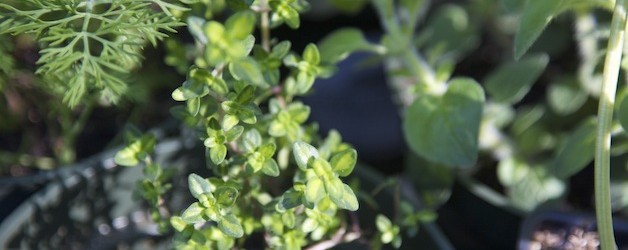

Fresh herbs are a wonderful, versatile ingredient that bring great flavor to dishes, and often, you don’t need to use much to get that flavor. In addition to brightening flavor, herbs are also a nutritional resource of vitamins and antioxidants. Although widely available in stores, growing your own herbs is easy, a lot less expensive, and you always have them available for adding to a meal. Summer is a great time to start a small herb pot or garden, so in addition to going over some herb basics, we’ll also give you our tips for growing your own.
Storing, Drying, and Freezing
Whether you buy fresh herbs at the store or grow your own herbs for cooking, we have some suggestions on how to preserve them. Farmer’s markets are a great source for local, healthy herb starters and cuttings. These ideas are particularly useful with pre-bundled or packaged store-bought herbs since you often don’t need as much for a single recipe as you have to purchase.
Storing
- Cut off the stems of leafy herbs, like parsley, dill, and cilantro, and place in a small amount of water, as you would fresh flowers. Slip a plastic bag over the top of the veggies, and place in the fridge. There are new products available, herb savors, that are designed for this kind of storage.
- Place herbs wrapped in moist paper towels into a zip-top plastic bag and store in the crisper drawer.
Drying
- The conventional way to dry herbs is to bundle washed herbs together and hang them upside down in a space that is cool, airy, and not in direct sunlight.
- We got this tip from Cook’s Illustrated: Use your microwave to dry herbs. Place the herbs in between two sheets of paper towel, and heat for 1 to 3 minutes.
- Once the herbs are dry, store stripped herb leaves in airtight containers.
- A general rule about substituting dried herbs for fresh in a recipe, or vice versa: use ½ the amount of dried you would use for fresh.
- Dried herbs tend to lose flavor over time, so try to use them within 6 months.
Freezing
- If freezing herb cuttings, or leaves, whole, lay them out on a cookie sheet and freeze until they are firm. Then transfer them to a freezer bag, and don’t forget to label them.
- Fill ice cube trays halfway with chopped herbs, and then cover with oil, water, or broth. Once the cubes are frozen, you can store them in a freezer bag.
General Guidelines for Growing Fresh Herbs
Since I learned so much by talking to people who grow herbs themselves, my best advice is to ask questions when you purchase seeds and/or herb starts to determine which plants will grow well under your specific conditions. A great online resource is The Herb Society of America.
Helpful tips for growing herbs:
- Plant the herbs you will use most often. Our favorite culinary herbs are: basil, parsley, rosemary, cilantro, oregano, thyme, dill, tarragon, sage, and mint.
- When planting herbs in garden beds or containers, both need good drainage and ample sunlight to grow. 6+ hours/day is ideal.
- Cut back basil, parsley, cilantro, and dill more often than you think to promote a more healthy, leafy plant. Don’t cut more than a 1/3 off the top of the plant at a time, and harvest these herbs before they flower for best flavor.
- Planting in isolated containers. Some herbs (rosemary and all mint varieties are examples) are pretty aggressive and can take over your garden or container, so it is best to plant these in their own container, or isolate them in the ground by planting them in a container that you can bury underground. (While the container will keep the herb from spreading, it will not be visible.)
- When purchasing herb starts rather than seeds, make sure they are not flowering and do not have roots sticking out of the bottom of the container.
- Stagger the planting of herbs that need to be cut back often, like basil, parsley and cilantro, so you have a steady supply of leaves to use in your cooking.
- “Mediterranean” herbs, like rosemary, oregano, and thyme don’t need as much water as other herbs.
Our Favorite Culinary Herbs
Here is a quick reference list of our favorite herbs for cooking, and some suggestions for how to use them.
Butcher Shop Chicken
This recipe from chef John Besh, published in the July 2014 Food and Wine, is a simple, delicious way to roast chicken with great herb flavor. Serve this chicken with the sautéed tomatoes, also from John Besh, that we wrote about a few weeks ago.
- 2 shallots
- 1 carrot, chopped
- 1 celery rib, chopped
- 2 bone-in chicken breast halves, with skin
- 2 whole chicken legs
- 3 Tablespoons extra-virgin olive oil
- Kosher salt and black pepper
- 1 1/2 teaspoons chopped rosemary leaves
- 1 teaspoon finely chopped thyme leaves
- 3 Tablespoons finely chopped basil leaves
Preheat the oven to 450 degrees. In a small roasting pan, scatter the shallots, carrot, and celery in an even layer. Rub the chicken with 2 tablespoons of the olive oil, then generously season with salt and black pepper. Arrange the chicken skin side up on top of the vegetables in the pan. Sprinkle with the rosemary, thyme, and 1 tablespoon of the basil over the chicken. Roast for 35 minutes, until an instant-read thermometer inserted in an inner thigh registers 165 degrees. The skin should be golden and the juices should run clear.
Versatile Recipe for Herbs: Compound Butter
A great way to use up extra herbs is to make a compound butter. All compound butters are made using the same method of adding ingredients to softened butter, so you can easily experiment with different flavors. They can be used on anything from rustic bread, sautéed or steamed veggies, corn on the cob, baked potatoes. They can be spread on cooked chicken, meats, or fish. Check out this basic recipe for compound butter.
Ina Garten’s Herb-Marinated Pork Tenderloin
This recipe in Barefoot Contessa Back to Basics by Ina Garten can be marinated ahead of time, and grilled or roasted in the oven (here is the link for oven-roasting instructions). The recipe is for 3 pork tenderloins so it is a great double batch dish if you have a small family.
- Grated zest of 1 lemon
- 3/4 cup freshly squeezed lemon juice (4-6 lemons)
- 1/2 cup good olive oil, plus extra for brushing the grill
- 2 tablespoons minced garlic (6 cloves)
- 1 1/2 tablespoons minced fresh rosemary leaves
- 1 tablespoons chopped fresh thyme leaves
- 2 teaspoon Dijon mustard
- Kosher salt
- 3 pork tenderloins (about 1 pound each)
- Freshly ground black pepper
Combine the lemon zest, lemon juice, olive oil, garlic, rosemary, thyme, mustard, and 2 tsp salt in a sturdy 1-gallon resealable plastic bag. Add the pork tenderloins and turn to coat the marinade. Squeeze out the air and seal the bag. Marinate the pork in the refrigerator for at least 3 hours but preferably overnight.
When you’re ready to cook, build a charcoal fire or heat a gas grill. Brush the cooking grate with oil to prevent the pork from sticking. Remove the tenderloins from the marinade and discard the marinade but leave the herbs that cling to the meat. Sprinkle the tenderloins generously with salt and pepper. Grill the tenderloins, turning a few times to brown on all sides, for 15 to 25 minutes (depending on the heat of the coals) until the meat registers 137 degrees at the thickest part. Transfer the tenderloins to a platter and cover with foil. Allow to rest for 10 minutes. Carve in 1/2-inch-thick diagonal slices. The thickest part of the tenderloin will be quite pink (it’s just fine!) and the thinnest part will be well done. Season with salt and pepper and serve warm, or at room temperature with the juices that collect in the platter. Serves 6.
Cheers!
